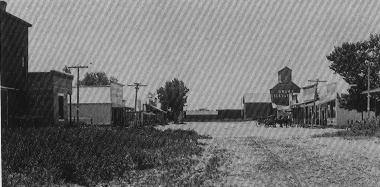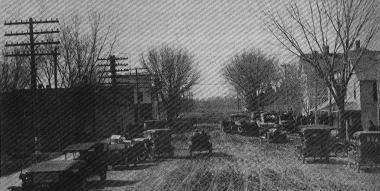
Brady, a town of 375 once called Brady Island, was given its name by John Fremont. While exploring Nebraska, he found some trappers on an island 15 miles east of the forks of the Platte River. Their leader was a man called Brady, so Fremont marked his map "Brady's Island." As a result of the great overland migration across Nebraska, many towns sprang up to serve as way-stations. The building of the railroad brought many more people to the area, as did the freight business development due to the heavy demand for goods and supplies from the east. In the 1860s, when Union Pacific Railroad construction workers in the area numbered nearly 1,000, the town was a collection of tents and soddies along the river, the only water supply. When the construction gangs moved on, Brady Island became a deserted river site, except for G.W. and Sarah Parsons, who lived across the river, and John McCullaugh, Ed Springer, Ben Murphy, Byron Whightmans and Wm.G.I. Craig, who stayed on.
The first school was formed by chance in 1874 when a group of immigrant families stayed over due to an injury to one of their group. Enlarged several times, the present school was built in 1925. Roy Cochran, graduating in the first class from Brady High School in 1906, became the 24th Governor of Nebraska and served three terms from 1934-40. The present K-12 school district entails a large area, including residents from Jeffery Lake four miles south of town.
The town incorporated in 1907, at which time it officially changed its name from Brady Island to "Brady." (It took the railroad until 1955 to paint the "Island" off their depot.) From 1910 on, the town's physical structure took form. There was a weekly paper (in 1880, "The Brady Blade" and in 1908, "Brady Vindicator"), a bank, several grain elevators, the usual assortment of shops, a cream station, a pole and neckyoke factory. Brady also had a good city band and bandstand. Norm Edward, who built the drug store, invented "Vancoa," a medicated salve which helped many people through the influenza epidemic in 1918. Electricity was installed in 1914 and could be enjoyed by residents in the evening from 7:00 to 10:00 p.m.
Devastating blizzards, prairie fires, and disease brought death to residents as well as to thousands of head of cattle throughout the years. Brady, now primarily an agricultural community, has a good number of businesses. The boundaries have doubled since it was incorporated. Due to the ag crisis the town has recently suffered the loss of two mills that employed 15-20 people. Retired people, mainly descendants of early settlers, are among our present citizens. These people are proud of the appearance of their town and lots of volunteer work is done to keep Brady active and the appearance immaculate. Palmer Park has softball and baseball games every night, as well as tennis and volleyball courts, and a practice football field. In addition to attending school functions, winter time activities includes bingo and dances.
Brady is presently just trying to survive. With the farm economy up in the air and the railroad's cut in laborers, the lack of employment has put the town through hard times this past few years. Hopefully, the determination of the people to keep it alive will move Brady forward. By Lynne E. Johnson, Village Clerk |
| Copyright NEGenWeb |
 BRADY -- LINCOLN COUNTY
BRADY -- LINCOLN COUNTY There were
businesses at this location in the 1880s, but the town
was not formally laid out until January 1889. As one
of the railroad's pump house sites, early merchants
profited from having the trains stop here. Brady
Island had the only saloon between Grand Island and
Cheyenne for a time. The stockyards, where thousands
of head of cattle were brought for shipment, stretched
for almost half a mile along the tracks.
There were
businesses at this location in the 1880s, but the town
was not formally laid out until January 1889. As one
of the railroad's pump house sites, early merchants
profited from having the trains stop here. Brady
Island had the only saloon between Grand Island and
Cheyenne for a time. The stockyards, where thousands
of head of cattle were brought for shipment, stretched
for almost half a mile along the tracks. The first
church was built in 1892 at the present location of
the United Methodist, with a second church built and
enlarged in 1925. Sacred Heart Catholic Church was
built in 1910. The Berean Fundamental Church,
organized in 1954, dedicated its building in 1967.
The first
church was built in 1892 at the present location of
the United Methodist, with a second church built and
enlarged in 1925. Sacred Heart Catholic Church was
built in 1910. The Berean Fundamental Church,
organized in 1954, dedicated its building in 1967. Fourth of July
celebrations were big affairs in Brady. The Commercial
Club sponsored parades, balloon ascensions, and street
carnivals on Market Street that brought in as many as
5,000 people. Horse races, rodeos, and baseball were
among the early 1900s recreational activities.
Fourth of July
celebrations were big affairs in Brady. The Commercial
Club sponsored parades, balloon ascensions, and street
carnivals on Market Street that brought in as many as
5,000 people. Horse races, rodeos, and baseball were
among the early 1900s recreational activities. The
majority of the downtown consists of buildings
constructed in the early 1900s. Fire destroyed some
buildings in the past, but the grocery story (burned
in 1972) and a bar (in 1984) have been rebuilt with a
more modern look of steel construction.
The
majority of the downtown consists of buildings
constructed in the early 1900s. Fire destroyed some
buildings in the past, but the grocery story (burned
in 1972) and a bar (in 1984) have been rebuilt with a
more modern look of steel construction.